Accounting Fundamentals Assignment
VerifiedAdded on 2020/12/10
|19
|4647
|349
Homework Assignment
AI Summary
This assignment covers accounting fundamentals, including ledger accounts, trial balance, and financial statements. It analyzes various companies, demonstrating the application of accounting principles in real-world scenarios. The assignment also distinguishes between revenue expenditure and capital expenditure, providing a comprehensive understanding of these key accounting concepts.
Contribute Materials
Your contribution can guide someone’s learning journey. Share your
documents today.
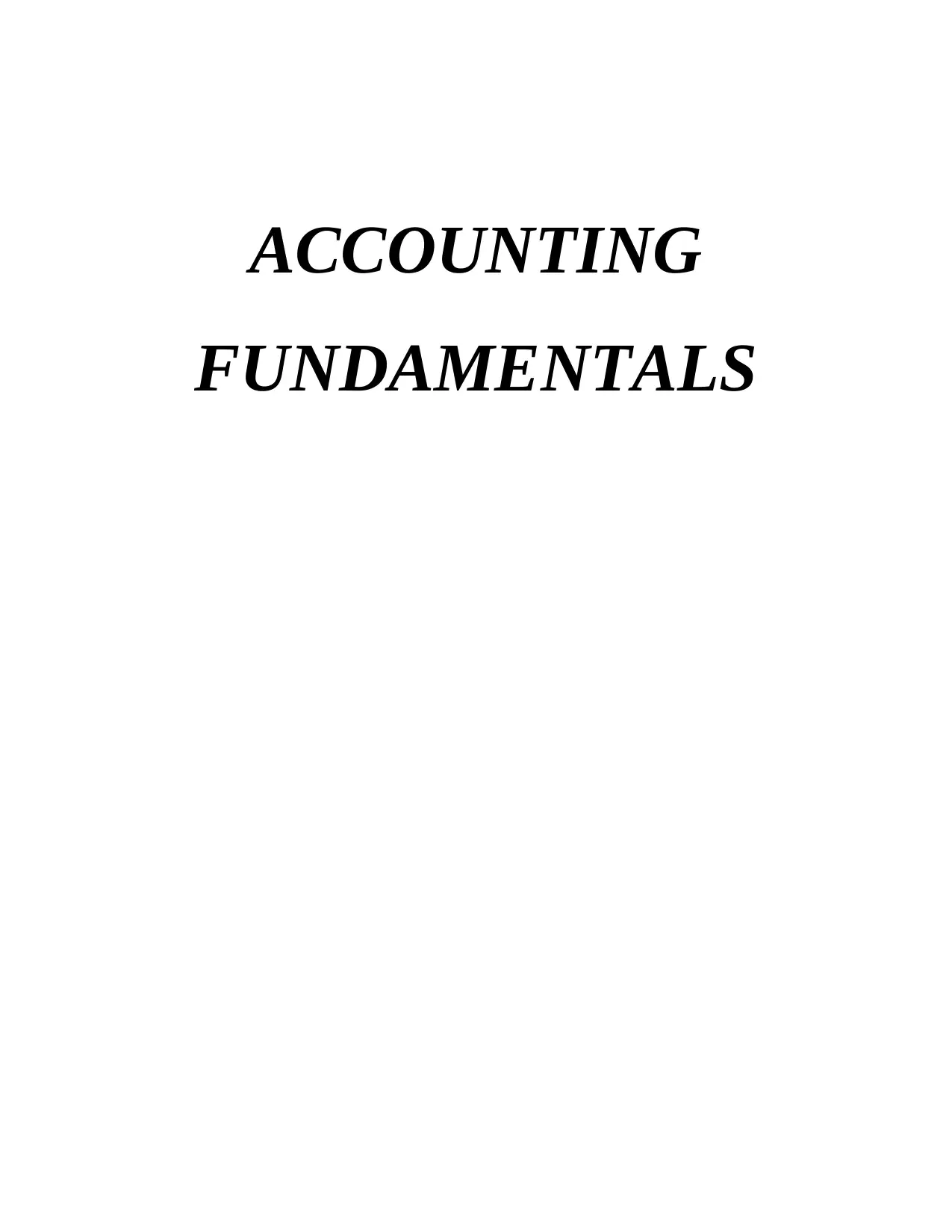
ACCOUNTING
FUNDAMENTALS
FUNDAMENTALS
Secure Best Marks with AI Grader
Need help grading? Try our AI Grader for instant feedback on your assignments.
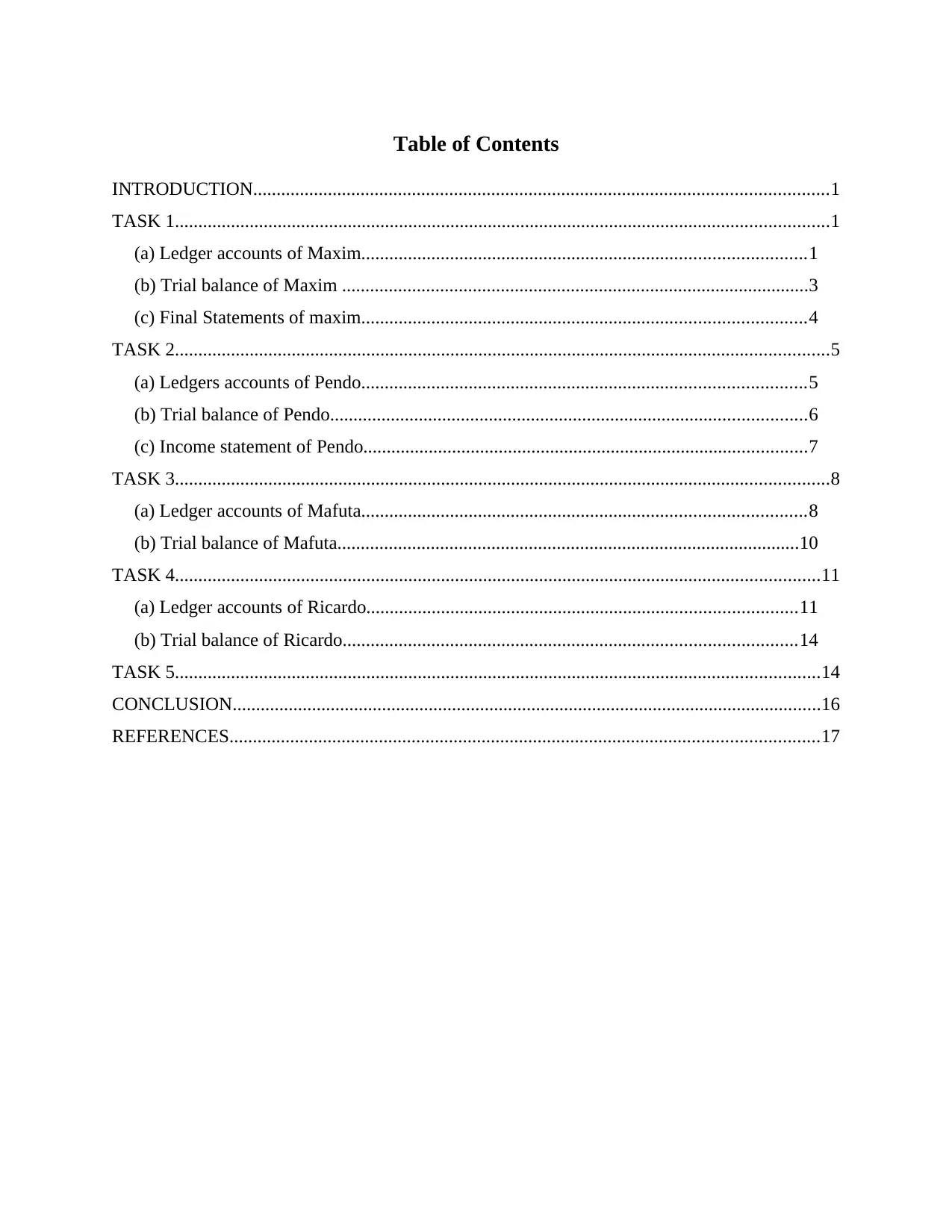
Table of Contents
INTRODUCTION...........................................................................................................................1
TASK 1............................................................................................................................................1
(a) Ledger accounts of Maxim...............................................................................................1
(b) Trial balance of Maxim ....................................................................................................3
(c) Final Statements of maxim...............................................................................................4
TASK 2............................................................................................................................................5
(a) Ledgers accounts of Pendo...............................................................................................5
(b) Trial balance of Pendo......................................................................................................6
(c) Income statement of Pendo...............................................................................................7
TASK 3............................................................................................................................................8
(a) Ledger accounts of Mafuta...............................................................................................8
(b) Trial balance of Mafuta...................................................................................................10
TASK 4..........................................................................................................................................11
(a) Ledger accounts of Ricardo............................................................................................11
(b) Trial balance of Ricardo.................................................................................................14
TASK 5..........................................................................................................................................14
CONCLUSION..............................................................................................................................16
REFERENCES..............................................................................................................................17
INTRODUCTION...........................................................................................................................1
TASK 1............................................................................................................................................1
(a) Ledger accounts of Maxim...............................................................................................1
(b) Trial balance of Maxim ....................................................................................................3
(c) Final Statements of maxim...............................................................................................4
TASK 2............................................................................................................................................5
(a) Ledgers accounts of Pendo...............................................................................................5
(b) Trial balance of Pendo......................................................................................................6
(c) Income statement of Pendo...............................................................................................7
TASK 3............................................................................................................................................8
(a) Ledger accounts of Mafuta...............................................................................................8
(b) Trial balance of Mafuta...................................................................................................10
TASK 4..........................................................................................................................................11
(a) Ledger accounts of Ricardo............................................................................................11
(b) Trial balance of Ricardo.................................................................................................14
TASK 5..........................................................................................................................................14
CONCLUSION..............................................................................................................................16
REFERENCES..............................................................................................................................17
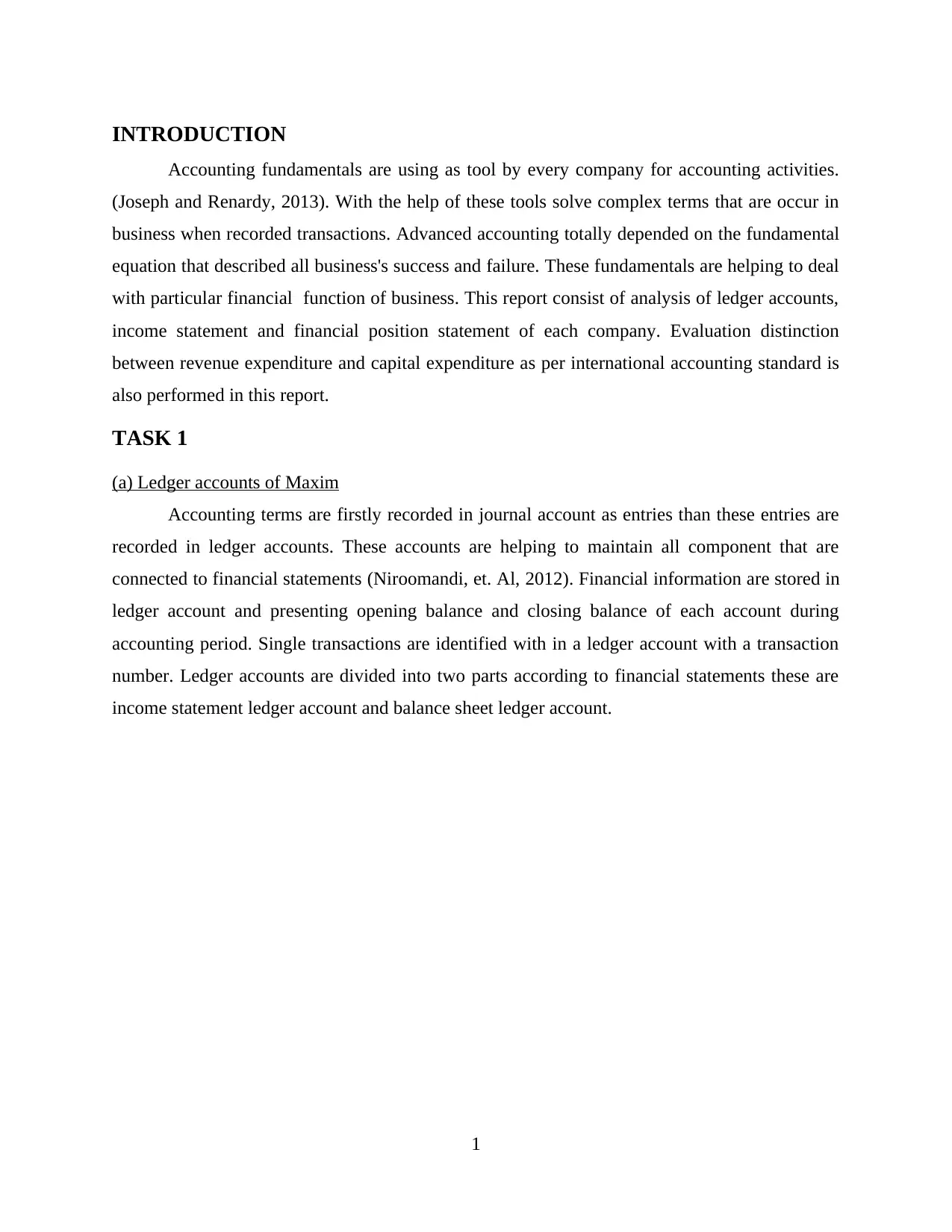
INTRODUCTION
Accounting fundamentals are using as tool by every company for accounting activities.
(Joseph and Renardy, 2013). With the help of these tools solve complex terms that are occur in
business when recorded transactions. Advanced accounting totally depended on the fundamental
equation that described all business's success and failure. These fundamentals are helping to deal
with particular financial function of business. This report consist of analysis of ledger accounts,
income statement and financial position statement of each company. Evaluation distinction
between revenue expenditure and capital expenditure as per international accounting standard is
also performed in this report.
TASK 1
(a) Ledger accounts of Maxim
Accounting terms are firstly recorded in journal account as entries than these entries are
recorded in ledger accounts. These accounts are helping to maintain all component that are
connected to financial statements (Niroomandi, et. Al, 2012). Financial information are stored in
ledger account and presenting opening balance and closing balance of each account during
accounting period. Single transactions are identified with in a ledger account with a transaction
number. Ledger accounts are divided into two parts according to financial statements these are
income statement ledger account and balance sheet ledger account.
1
Accounting fundamentals are using as tool by every company for accounting activities.
(Joseph and Renardy, 2013). With the help of these tools solve complex terms that are occur in
business when recorded transactions. Advanced accounting totally depended on the fundamental
equation that described all business's success and failure. These fundamentals are helping to deal
with particular financial function of business. This report consist of analysis of ledger accounts,
income statement and financial position statement of each company. Evaluation distinction
between revenue expenditure and capital expenditure as per international accounting standard is
also performed in this report.
TASK 1
(a) Ledger accounts of Maxim
Accounting terms are firstly recorded in journal account as entries than these entries are
recorded in ledger accounts. These accounts are helping to maintain all component that are
connected to financial statements (Niroomandi, et. Al, 2012). Financial information are stored in
ledger account and presenting opening balance and closing balance of each account during
accounting period. Single transactions are identified with in a ledger account with a transaction
number. Ledger accounts are divided into two parts according to financial statements these are
income statement ledger account and balance sheet ledger account.
1
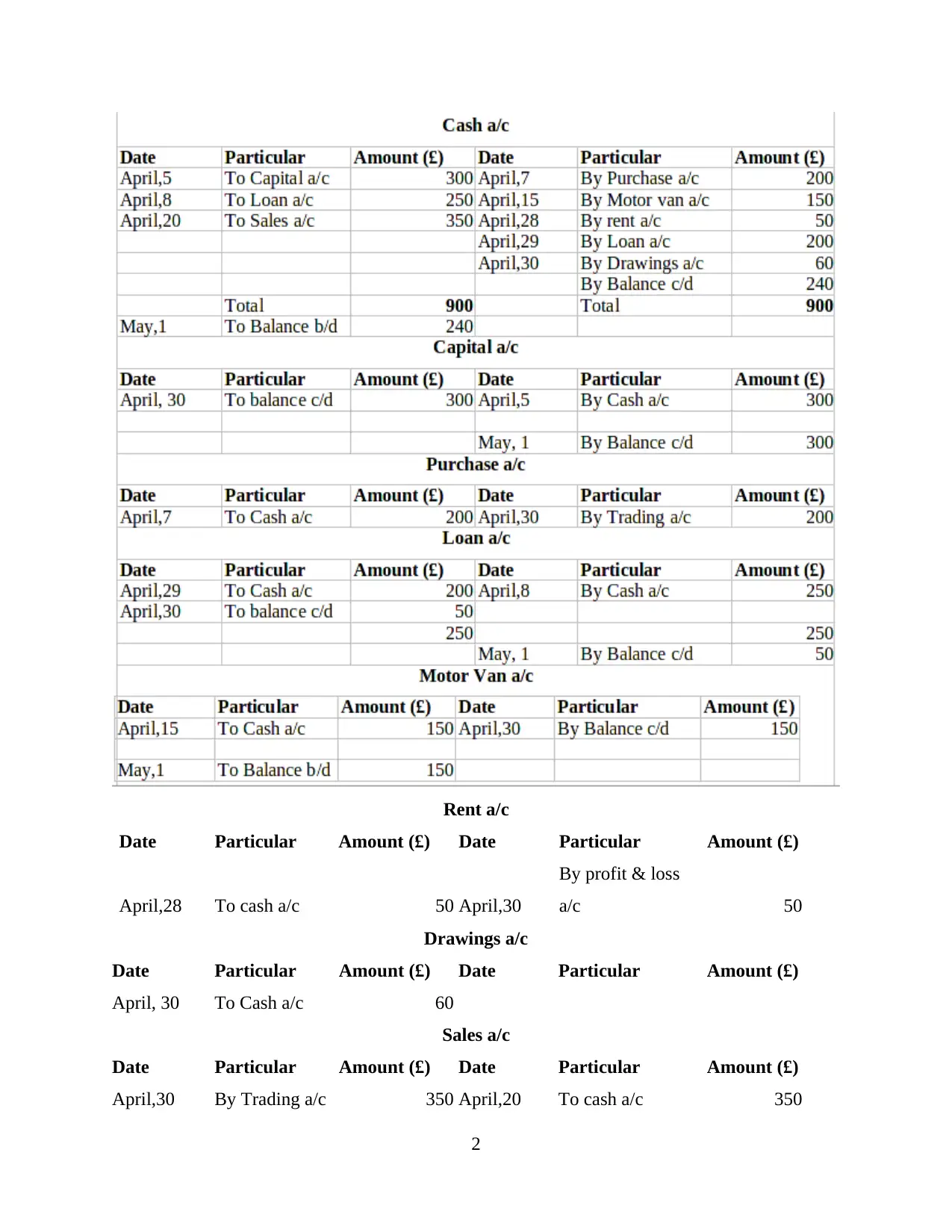
Rent a/c
Date Particular Amount (£) Date Particular Amount (£)
April,28 To cash a/c 50 April,30
By profit & loss
a/c 50
Drawings a/c
Date Particular Amount (£) Date Particular Amount (£)
April, 30 To Cash a/c 60
Sales a/c
Date Particular Amount (£) Date Particular Amount (£)
April,30 By Trading a/c 350 April,20 To cash a/c 350
2
Date Particular Amount (£) Date Particular Amount (£)
April,28 To cash a/c 50 April,30
By profit & loss
a/c 50
Drawings a/c
Date Particular Amount (£) Date Particular Amount (£)
April, 30 To Cash a/c 60
Sales a/c
Date Particular Amount (£) Date Particular Amount (£)
April,30 By Trading a/c 350 April,20 To cash a/c 350
2
Secure Best Marks with AI Grader
Need help grading? Try our AI Grader for instant feedback on your assignments.
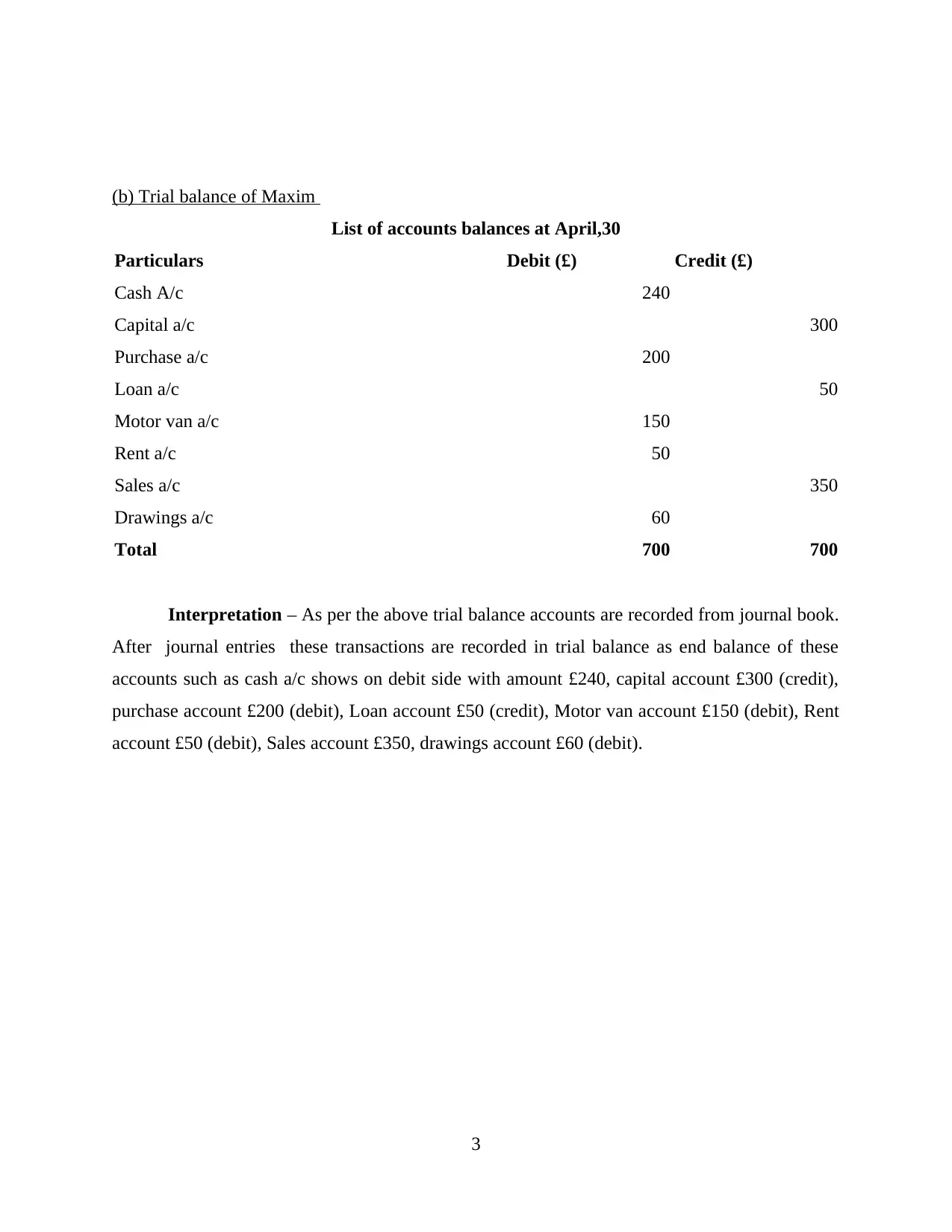
(b) Trial balance of Maxim
List of accounts balances at April,30
Particulars Debit (£) Credit (£)
Cash A/c 240
Capital a/c 300
Purchase a/c 200
Loan a/c 50
Motor van a/c 150
Rent a/c 50
Sales a/c 350
Drawings a/c 60
Total 700 700
Interpretation – As per the above trial balance accounts are recorded from journal book.
After journal entries these transactions are recorded in trial balance as end balance of these
accounts such as cash a/c shows on debit side with amount £240, capital account £300 (credit),
purchase account £200 (debit), Loan account £50 (credit), Motor van account £150 (debit), Rent
account £50 (debit), Sales account £350, drawings account £60 (debit).
3
List of accounts balances at April,30
Particulars Debit (£) Credit (£)
Cash A/c 240
Capital a/c 300
Purchase a/c 200
Loan a/c 50
Motor van a/c 150
Rent a/c 50
Sales a/c 350
Drawings a/c 60
Total 700 700
Interpretation – As per the above trial balance accounts are recorded from journal book.
After journal entries these transactions are recorded in trial balance as end balance of these
accounts such as cash a/c shows on debit side with amount £240, capital account £300 (credit),
purchase account £200 (debit), Loan account £50 (credit), Motor van account £150 (debit), Rent
account £50 (debit), Sales account £350, drawings account £60 (debit).
3
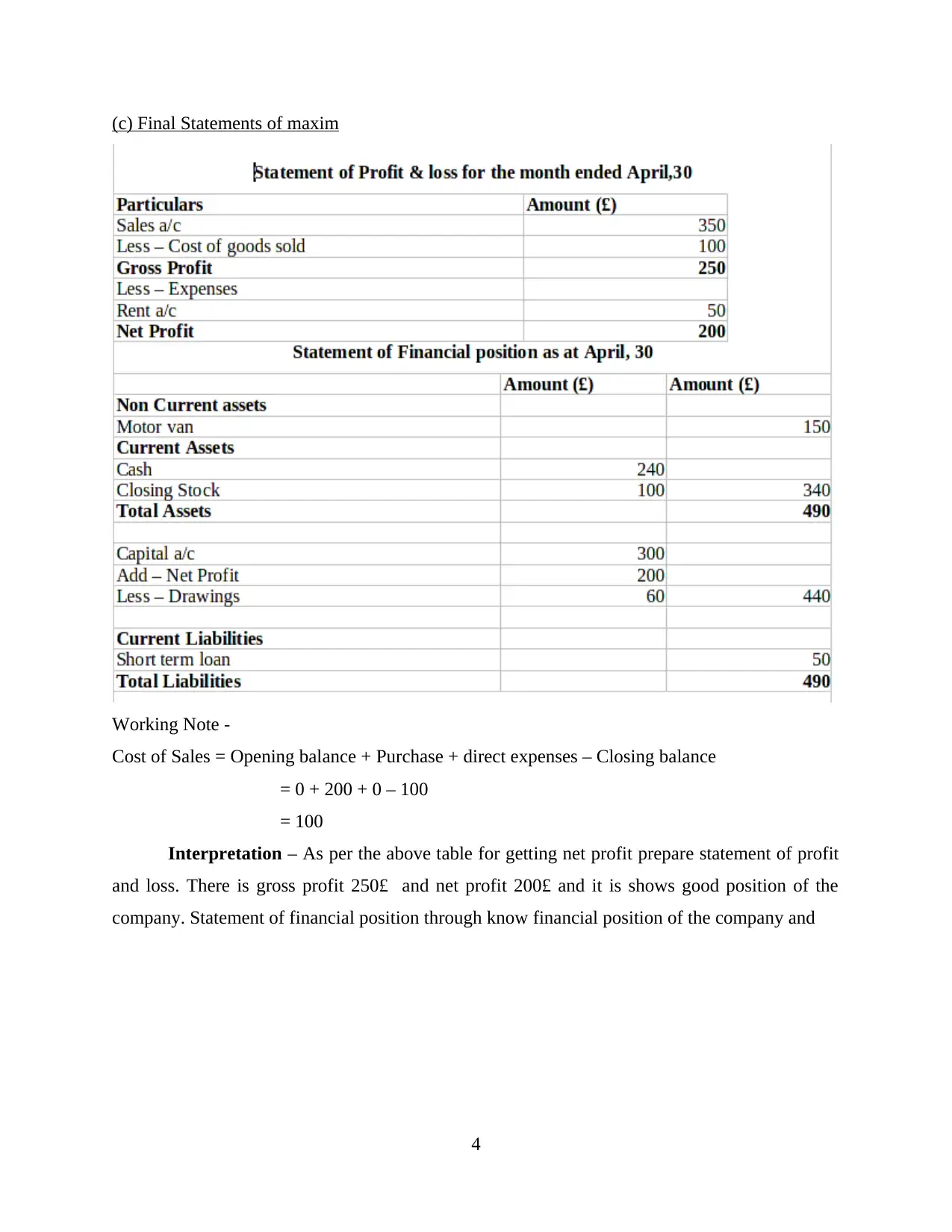
(c) Final Statements of maxim
Working Note -
Cost of Sales = Opening balance + Purchase + direct expenses – Closing balance
= 0 + 200 + 0 – 100
= 100
Interpretation – As per the above table for getting net profit prepare statement of profit
and loss. There is gross profit 250£ and net profit 200£ and it is shows good position of the
company. Statement of financial position through know financial position of the company and
4
Working Note -
Cost of Sales = Opening balance + Purchase + direct expenses – Closing balance
= 0 + 200 + 0 – 100
= 100
Interpretation – As per the above table for getting net profit prepare statement of profit
and loss. There is gross profit 250£ and net profit 200£ and it is shows good position of the
company. Statement of financial position through know financial position of the company and
4
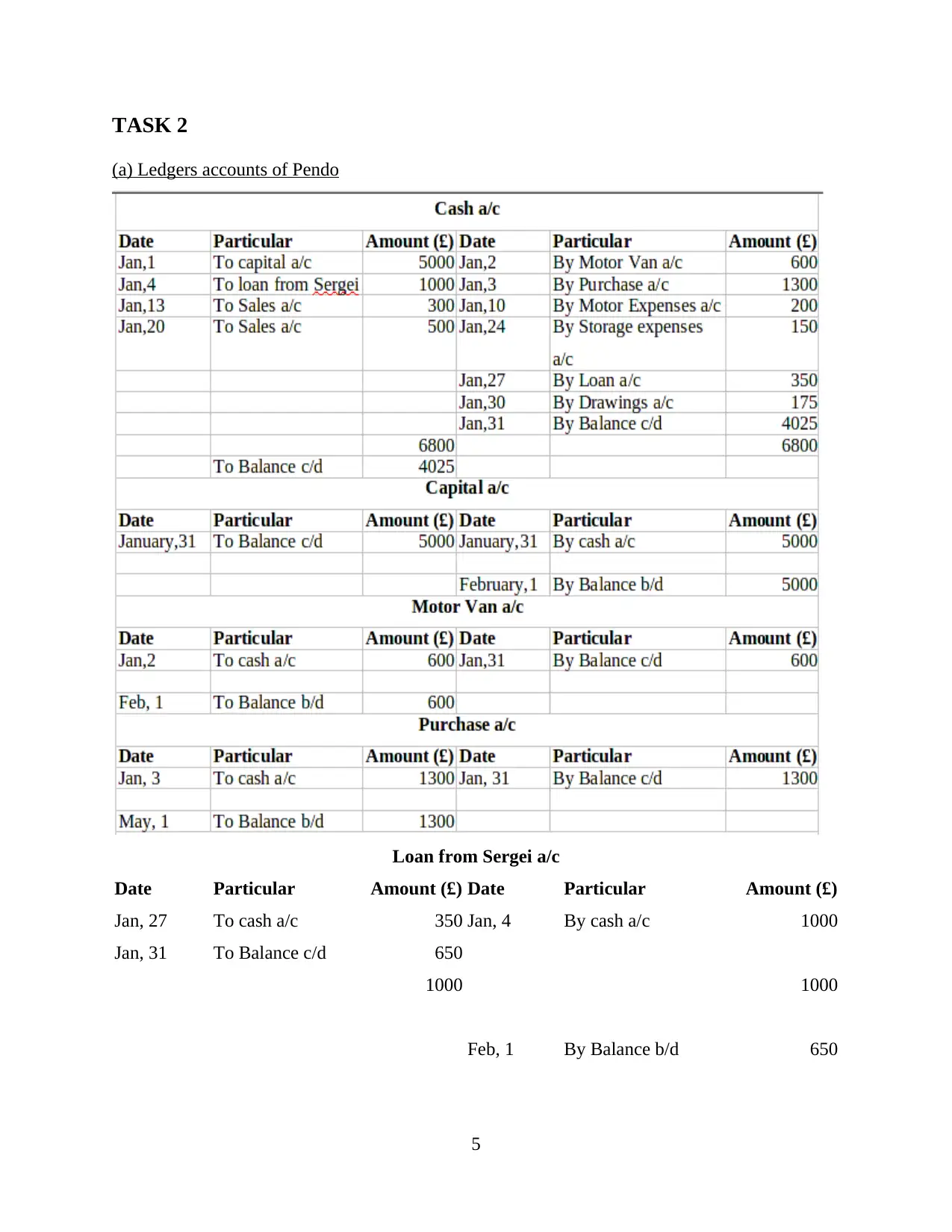
TASK 2
(a) Ledgers accounts of Pendo
Loan from Sergei a/c
Date Particular Amount (£) Date Particular Amount (£)
Jan, 27 To cash a/c 350 Jan, 4 By cash a/c 1000
Jan, 31 To Balance c/d 650
1000 1000
Feb, 1 By Balance b/d 650
5
(a) Ledgers accounts of Pendo
Loan from Sergei a/c
Date Particular Amount (£) Date Particular Amount (£)
Jan, 27 To cash a/c 350 Jan, 4 By cash a/c 1000
Jan, 31 To Balance c/d 650
1000 1000
Feb, 1 By Balance b/d 650
5
Paraphrase This Document
Need a fresh take? Get an instant paraphrase of this document with our AI Paraphraser
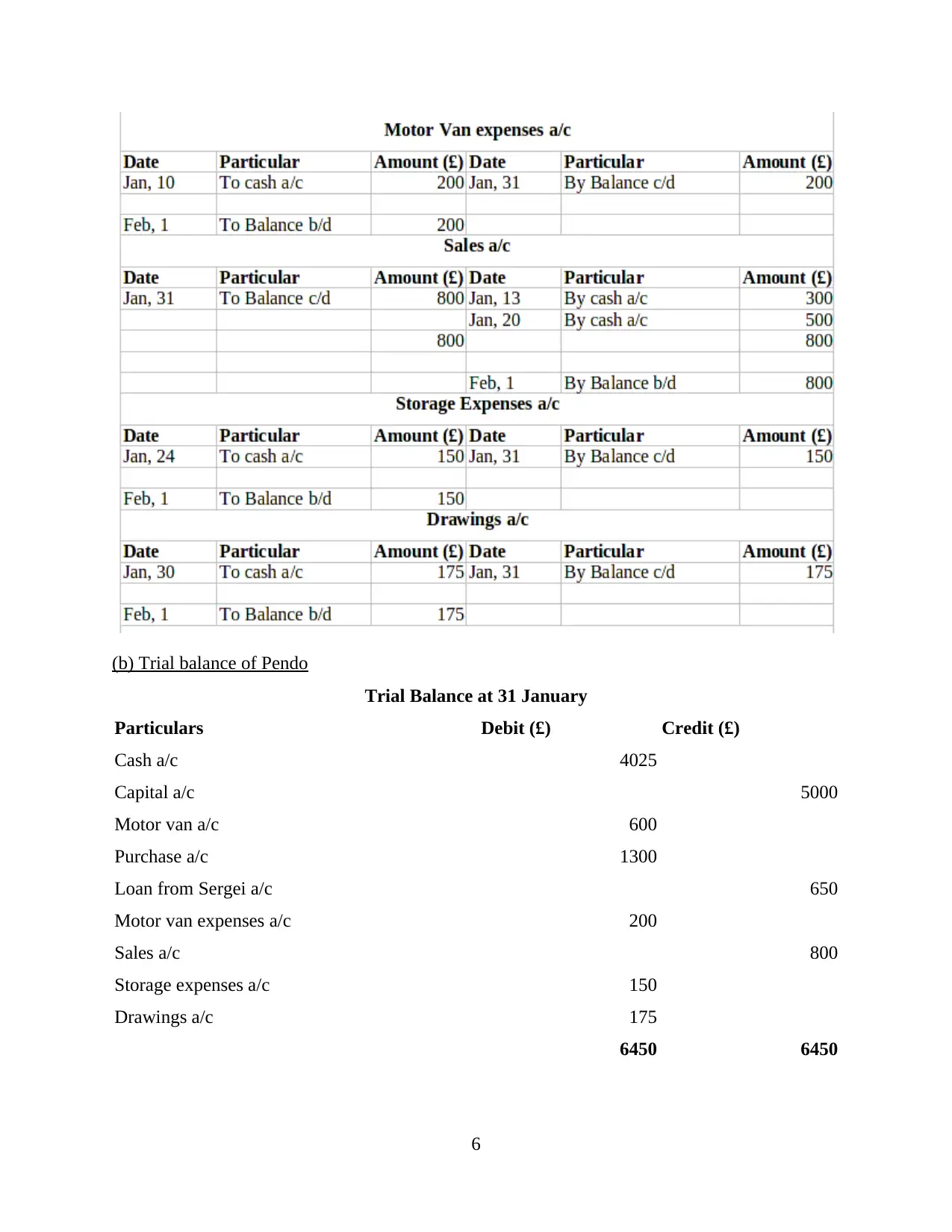
(b) Trial balance of Pendo
Trial Balance at 31 January
Particulars Debit (£) Credit (£)
Cash a/c 4025
Capital a/c 5000
Motor van a/c 600
Purchase a/c 1300
Loan from Sergei a/c 650
Motor van expenses a/c 200
Sales a/c 800
Storage expenses a/c 150
Drawings a/c 175
6450 6450
6
Trial Balance at 31 January
Particulars Debit (£) Credit (£)
Cash a/c 4025
Capital a/c 5000
Motor van a/c 600
Purchase a/c 1300
Loan from Sergei a/c 650
Motor van expenses a/c 200
Sales a/c 800
Storage expenses a/c 150
Drawings a/c 175
6450 6450
6
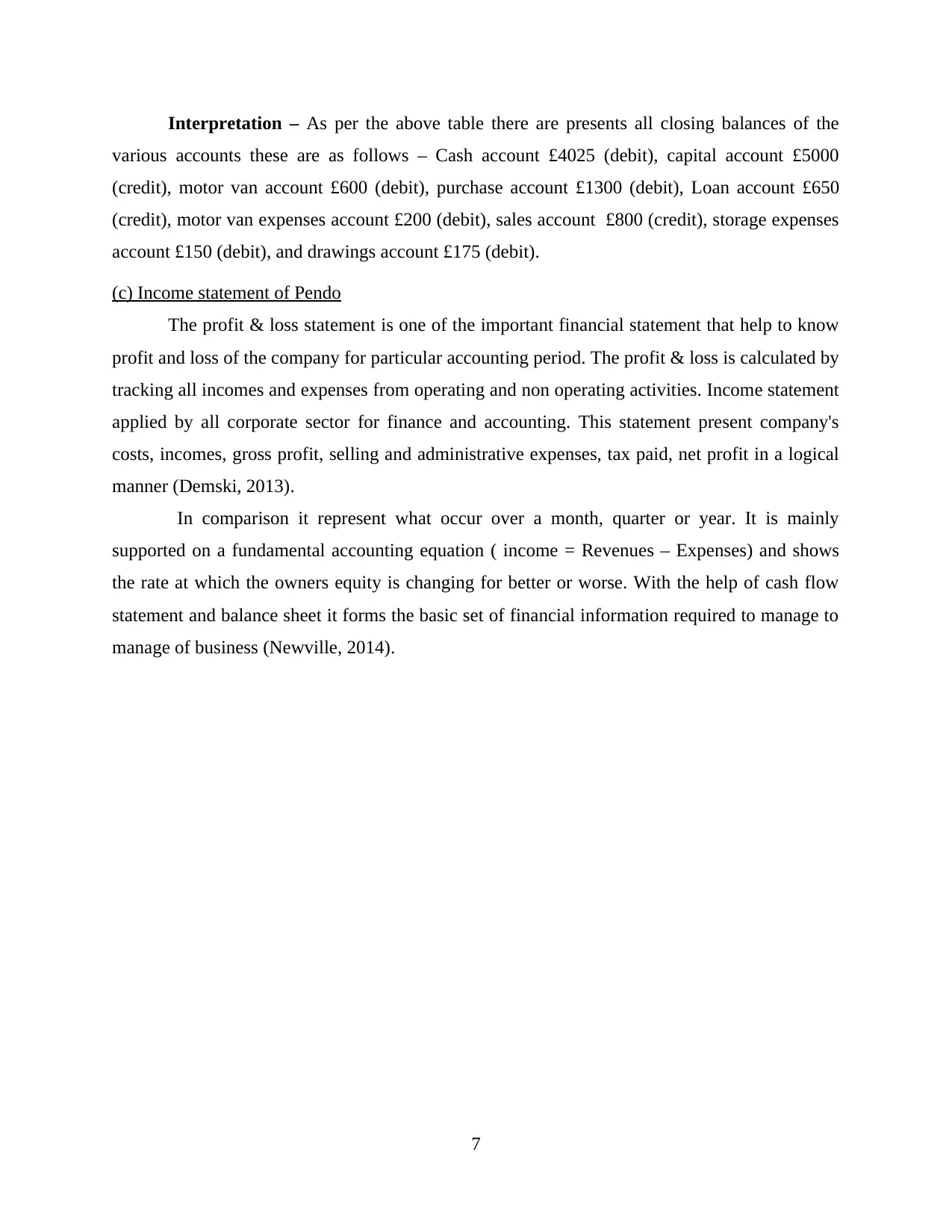
Interpretation – As per the above table there are presents all closing balances of the
various accounts these are as follows – Cash account £4025 (debit), capital account £5000
(credit), motor van account £600 (debit), purchase account £1300 (debit), Loan account £650
(credit), motor van expenses account £200 (debit), sales account £800 (credit), storage expenses
account £150 (debit), and drawings account £175 (debit).
(c) Income statement of Pendo
The profit & loss statement is one of the important financial statement that help to know
profit and loss of the company for particular accounting period. The profit & loss is calculated by
tracking all incomes and expenses from operating and non operating activities. Income statement
applied by all corporate sector for finance and accounting. This statement present company's
costs, incomes, gross profit, selling and administrative expenses, tax paid, net profit in a logical
manner (Demski, 2013).
In comparison it represent what occur over a month, quarter or year. It is mainly
supported on a fundamental accounting equation ( income = Revenues – Expenses) and shows
the rate at which the owners equity is changing for better or worse. With the help of cash flow
statement and balance sheet it forms the basic set of financial information required to manage to
manage of business (Newville, 2014).
7
various accounts these are as follows – Cash account £4025 (debit), capital account £5000
(credit), motor van account £600 (debit), purchase account £1300 (debit), Loan account £650
(credit), motor van expenses account £200 (debit), sales account £800 (credit), storage expenses
account £150 (debit), and drawings account £175 (debit).
(c) Income statement of Pendo
The profit & loss statement is one of the important financial statement that help to know
profit and loss of the company for particular accounting period. The profit & loss is calculated by
tracking all incomes and expenses from operating and non operating activities. Income statement
applied by all corporate sector for finance and accounting. This statement present company's
costs, incomes, gross profit, selling and administrative expenses, tax paid, net profit in a logical
manner (Demski, 2013).
In comparison it represent what occur over a month, quarter or year. It is mainly
supported on a fundamental accounting equation ( income = Revenues – Expenses) and shows
the rate at which the owners equity is changing for better or worse. With the help of cash flow
statement and balance sheet it forms the basic set of financial information required to manage to
manage of business (Newville, 2014).
7
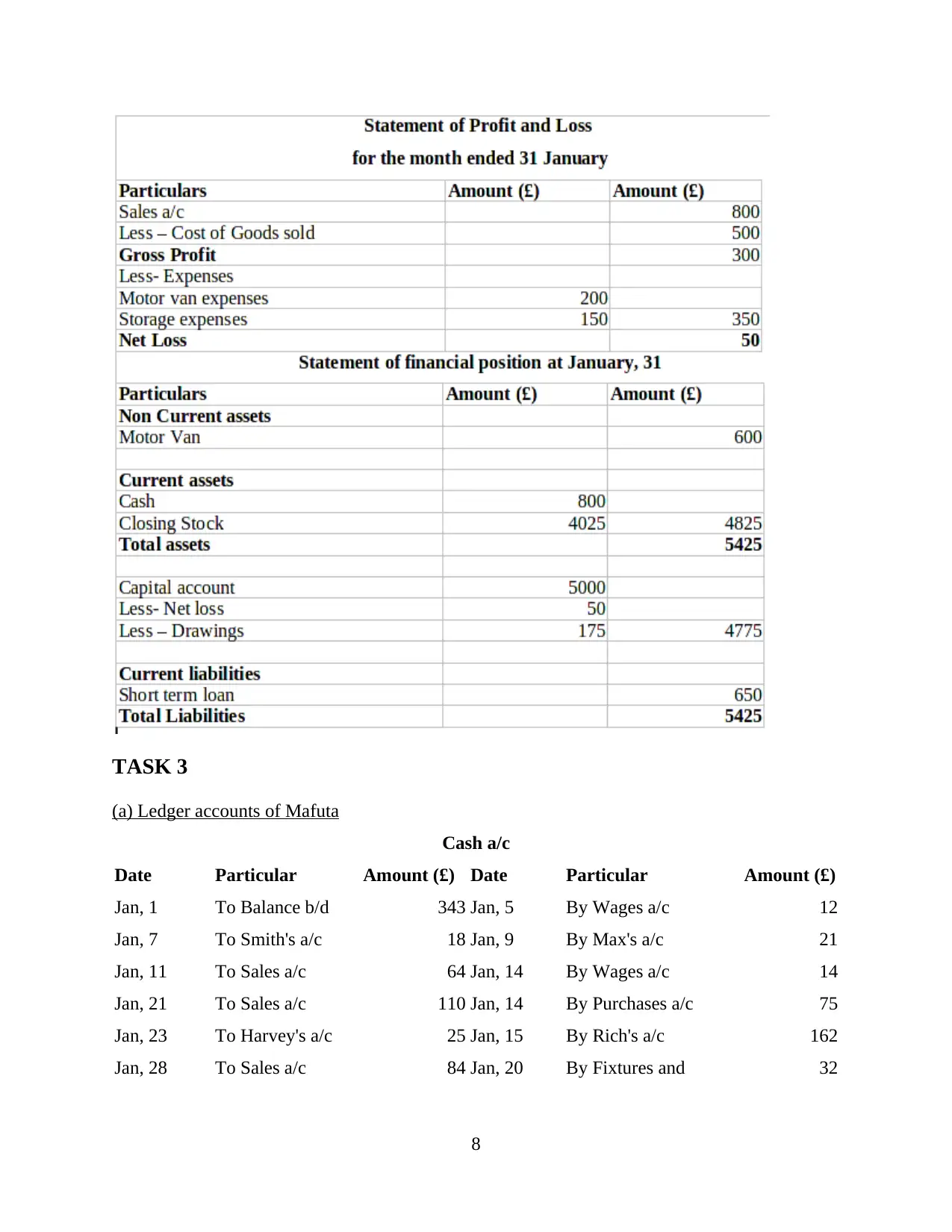
TASK 3
(a) Ledger accounts of Mafuta
Cash a/c
Date Particular Amount (£) Date Particular Amount (£)
Jan, 1 To Balance b/d 343 Jan, 5 By Wages a/c 12
Jan, 7 To Smith's a/c 18 Jan, 9 By Max's a/c 21
Jan, 11 To Sales a/c 64 Jan, 14 By Wages a/c 14
Jan, 21 To Sales a/c 110 Jan, 14 By Purchases a/c 75
Jan, 23 To Harvey's a/c 25 Jan, 15 By Rich's a/c 162
Jan, 28 To Sales a/c 84 Jan, 20 By Fixtures and 32
8
(a) Ledger accounts of Mafuta
Cash a/c
Date Particular Amount (£) Date Particular Amount (£)
Jan, 1 To Balance b/d 343 Jan, 5 By Wages a/c 12
Jan, 7 To Smith's a/c 18 Jan, 9 By Max's a/c 21
Jan, 11 To Sales a/c 64 Jan, 14 By Wages a/c 14
Jan, 21 To Sales a/c 110 Jan, 14 By Purchases a/c 75
Jan, 23 To Harvey's a/c 25 Jan, 15 By Rich's a/c 162
Jan, 28 To Sales a/c 84 Jan, 20 By Fixtures and 32
8
Secure Best Marks with AI Grader
Need help grading? Try our AI Grader for instant feedback on your assignments.
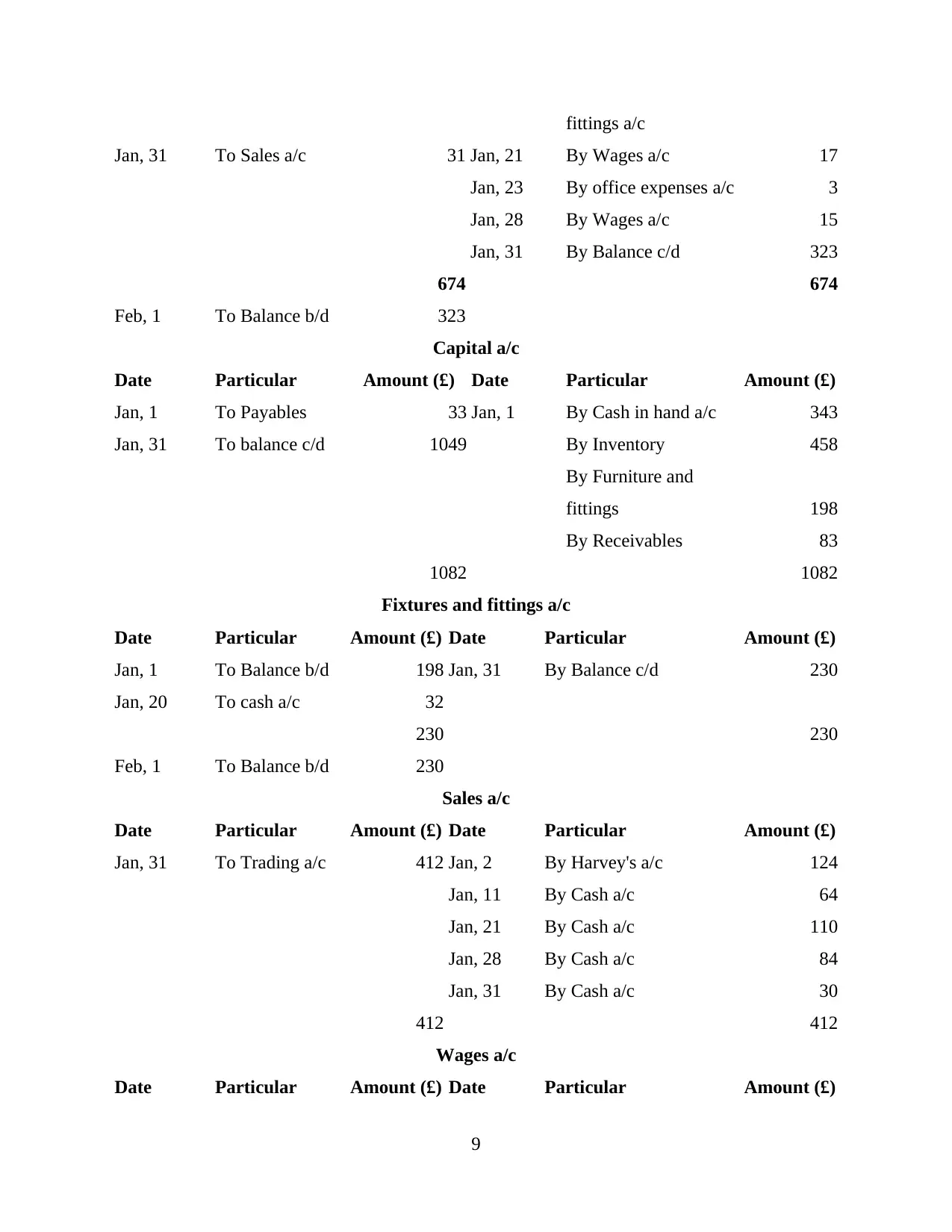
fittings a/c
Jan, 31 To Sales a/c 31 Jan, 21 By Wages a/c 17
Jan, 23 By office expenses a/c 3
Jan, 28 By Wages a/c 15
Jan, 31 By Balance c/d 323
674 674
Feb, 1 To Balance b/d 323
Capital a/c
Date Particular Amount (£) Date Particular Amount (£)
Jan, 1 To Payables 33 Jan, 1 By Cash in hand a/c 343
Jan, 31 To balance c/d 1049 By Inventory 458
By Furniture and
fittings 198
By Receivables 83
1082 1082
Fixtures and fittings a/c
Date Particular Amount (£) Date Particular Amount (£)
Jan, 1 To Balance b/d 198 Jan, 31 By Balance c/d 230
Jan, 20 To cash a/c 32
230 230
Feb, 1 To Balance b/d 230
Sales a/c
Date Particular Amount (£) Date Particular Amount (£)
Jan, 31 To Trading a/c 412 Jan, 2 By Harvey's a/c 124
Jan, 11 By Cash a/c 64
Jan, 21 By Cash a/c 110
Jan, 28 By Cash a/c 84
Jan, 31 By Cash a/c 30
412 412
Wages a/c
Date Particular Amount (£) Date Particular Amount (£)
9
Jan, 31 To Sales a/c 31 Jan, 21 By Wages a/c 17
Jan, 23 By office expenses a/c 3
Jan, 28 By Wages a/c 15
Jan, 31 By Balance c/d 323
674 674
Feb, 1 To Balance b/d 323
Capital a/c
Date Particular Amount (£) Date Particular Amount (£)
Jan, 1 To Payables 33 Jan, 1 By Cash in hand a/c 343
Jan, 31 To balance c/d 1049 By Inventory 458
By Furniture and
fittings 198
By Receivables 83
1082 1082
Fixtures and fittings a/c
Date Particular Amount (£) Date Particular Amount (£)
Jan, 1 To Balance b/d 198 Jan, 31 By Balance c/d 230
Jan, 20 To cash a/c 32
230 230
Feb, 1 To Balance b/d 230
Sales a/c
Date Particular Amount (£) Date Particular Amount (£)
Jan, 31 To Trading a/c 412 Jan, 2 By Harvey's a/c 124
Jan, 11 By Cash a/c 64
Jan, 21 By Cash a/c 110
Jan, 28 By Cash a/c 84
Jan, 31 By Cash a/c 30
412 412
Wages a/c
Date Particular Amount (£) Date Particular Amount (£)
9
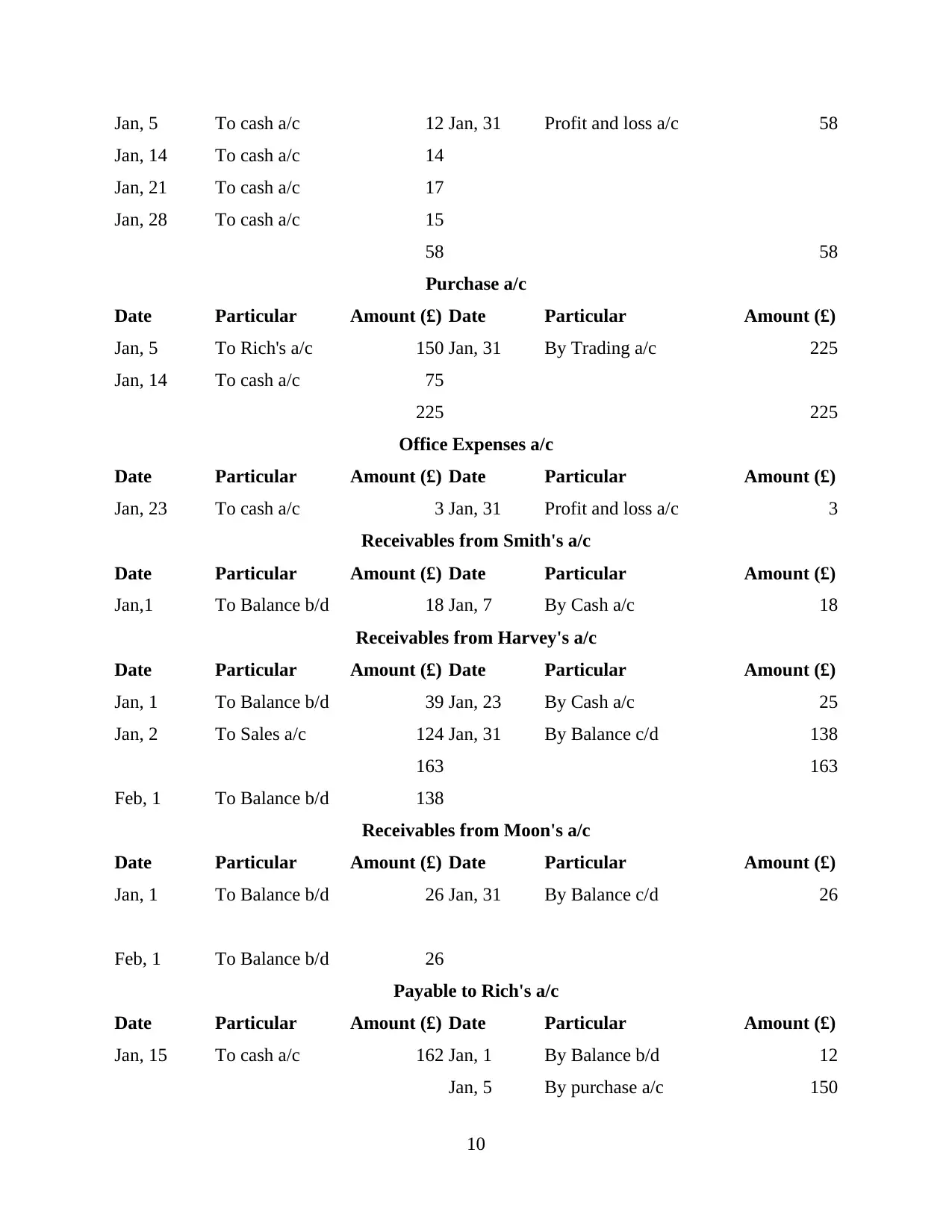
Jan, 5 To cash a/c 12 Jan, 31 Profit and loss a/c 58
Jan, 14 To cash a/c 14
Jan, 21 To cash a/c 17
Jan, 28 To cash a/c 15
58 58
Purchase a/c
Date Particular Amount (£) Date Particular Amount (£)
Jan, 5 To Rich's a/c 150 Jan, 31 By Trading a/c 225
Jan, 14 To cash a/c 75
225 225
Office Expenses a/c
Date Particular Amount (£) Date Particular Amount (£)
Jan, 23 To cash a/c 3 Jan, 31 Profit and loss a/c 3
Receivables from Smith's a/c
Date Particular Amount (£) Date Particular Amount (£)
Jan,1 To Balance b/d 18 Jan, 7 By Cash a/c 18
Receivables from Harvey's a/c
Date Particular Amount (£) Date Particular Amount (£)
Jan, 1 To Balance b/d 39 Jan, 23 By Cash a/c 25
Jan, 2 To Sales a/c 124 Jan, 31 By Balance c/d 138
163 163
Feb, 1 To Balance b/d 138
Receivables from Moon's a/c
Date Particular Amount (£) Date Particular Amount (£)
Jan, 1 To Balance b/d 26 Jan, 31 By Balance c/d 26
Feb, 1 To Balance b/d 26
Payable to Rich's a/c
Date Particular Amount (£) Date Particular Amount (£)
Jan, 15 To cash a/c 162 Jan, 1 By Balance b/d 12
Jan, 5 By purchase a/c 150
10
Jan, 14 To cash a/c 14
Jan, 21 To cash a/c 17
Jan, 28 To cash a/c 15
58 58
Purchase a/c
Date Particular Amount (£) Date Particular Amount (£)
Jan, 5 To Rich's a/c 150 Jan, 31 By Trading a/c 225
Jan, 14 To cash a/c 75
225 225
Office Expenses a/c
Date Particular Amount (£) Date Particular Amount (£)
Jan, 23 To cash a/c 3 Jan, 31 Profit and loss a/c 3
Receivables from Smith's a/c
Date Particular Amount (£) Date Particular Amount (£)
Jan,1 To Balance b/d 18 Jan, 7 By Cash a/c 18
Receivables from Harvey's a/c
Date Particular Amount (£) Date Particular Amount (£)
Jan, 1 To Balance b/d 39 Jan, 23 By Cash a/c 25
Jan, 2 To Sales a/c 124 Jan, 31 By Balance c/d 138
163 163
Feb, 1 To Balance b/d 138
Receivables from Moon's a/c
Date Particular Amount (£) Date Particular Amount (£)
Jan, 1 To Balance b/d 26 Jan, 31 By Balance c/d 26
Feb, 1 To Balance b/d 26
Payable to Rich's a/c
Date Particular Amount (£) Date Particular Amount (£)
Jan, 15 To cash a/c 162 Jan, 1 By Balance b/d 12
Jan, 5 By purchase a/c 150
10
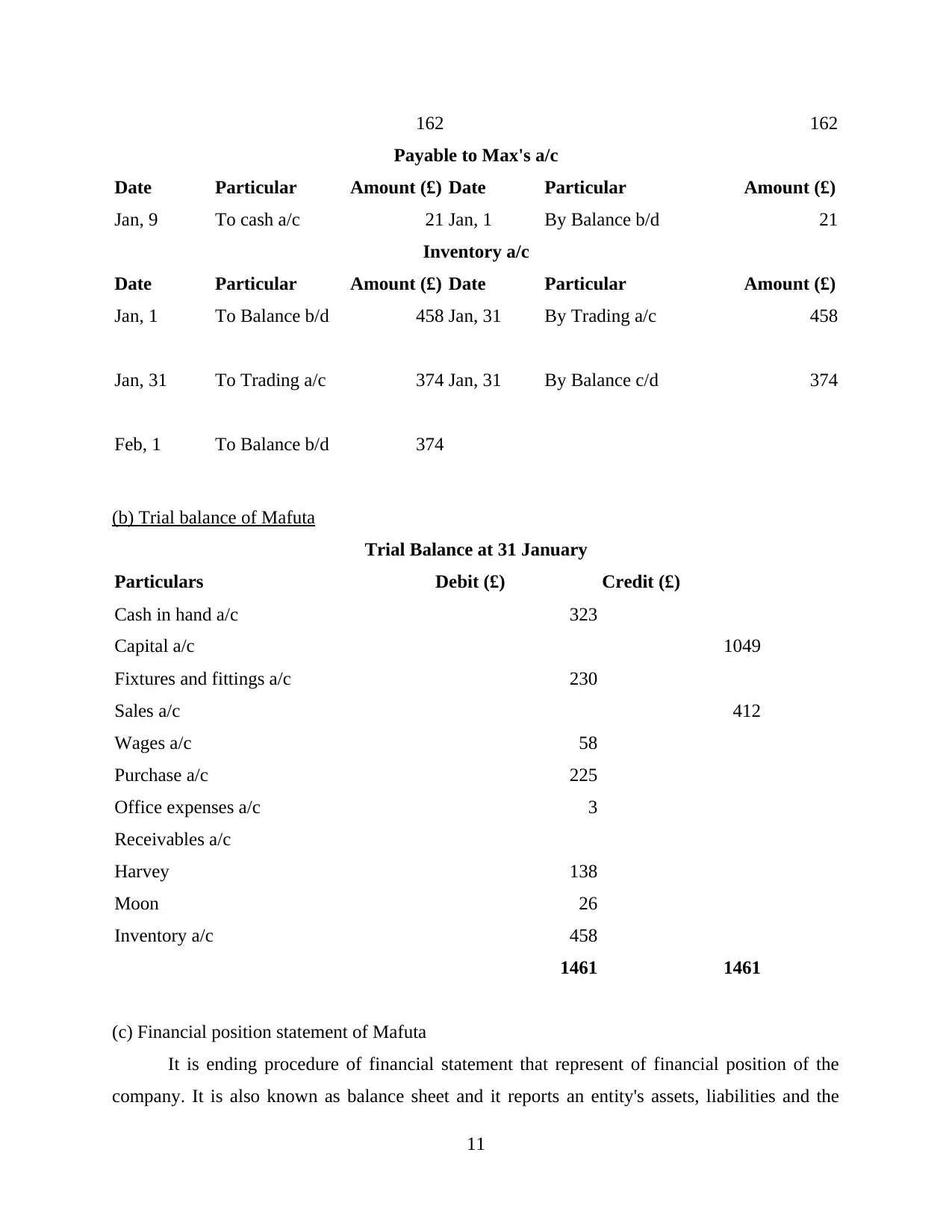
162 162
Payable to Max's a/c
Date Particular Amount (£) Date Particular Amount (£)
Jan, 9 To cash a/c 21 Jan, 1 By Balance b/d 21
Inventory a/c
Date Particular Amount (£) Date Particular Amount (£)
Jan, 1 To Balance b/d 458 Jan, 31 By Trading a/c 458
Jan, 31 To Trading a/c 374 Jan, 31 By Balance c/d 374
Feb, 1 To Balance b/d 374
(b) Trial balance of Mafuta
Trial Balance at 31 January
Particulars Debit (£) Credit (£)
Cash in hand a/c 323
Capital a/c 1049
Fixtures and fittings a/c 230
Sales a/c 412
Wages a/c 58
Purchase a/c 225
Office expenses a/c 3
Receivables a/c
Harvey 138
Moon 26
Inventory a/c 458
1461 1461
(c) Financial position statement of Mafuta
It is ending procedure of financial statement that represent of financial position of the
company. It is also known as balance sheet and it reports an entity's assets, liabilities and the
11
Payable to Max's a/c
Date Particular Amount (£) Date Particular Amount (£)
Jan, 9 To cash a/c 21 Jan, 1 By Balance b/d 21
Inventory a/c
Date Particular Amount (£) Date Particular Amount (£)
Jan, 1 To Balance b/d 458 Jan, 31 By Trading a/c 458
Jan, 31 To Trading a/c 374 Jan, 31 By Balance c/d 374
Feb, 1 To Balance b/d 374
(b) Trial balance of Mafuta
Trial Balance at 31 January
Particulars Debit (£) Credit (£)
Cash in hand a/c 323
Capital a/c 1049
Fixtures and fittings a/c 230
Sales a/c 412
Wages a/c 58
Purchase a/c 225
Office expenses a/c 3
Receivables a/c
Harvey 138
Moon 26
Inventory a/c 458
1461 1461
(c) Financial position statement of Mafuta
It is ending procedure of financial statement that represent of financial position of the
company. It is also known as balance sheet and it reports an entity's assets, liabilities and the
11
Paraphrase This Document
Need a fresh take? Get an instant paraphrase of this document with our AI Paraphraser
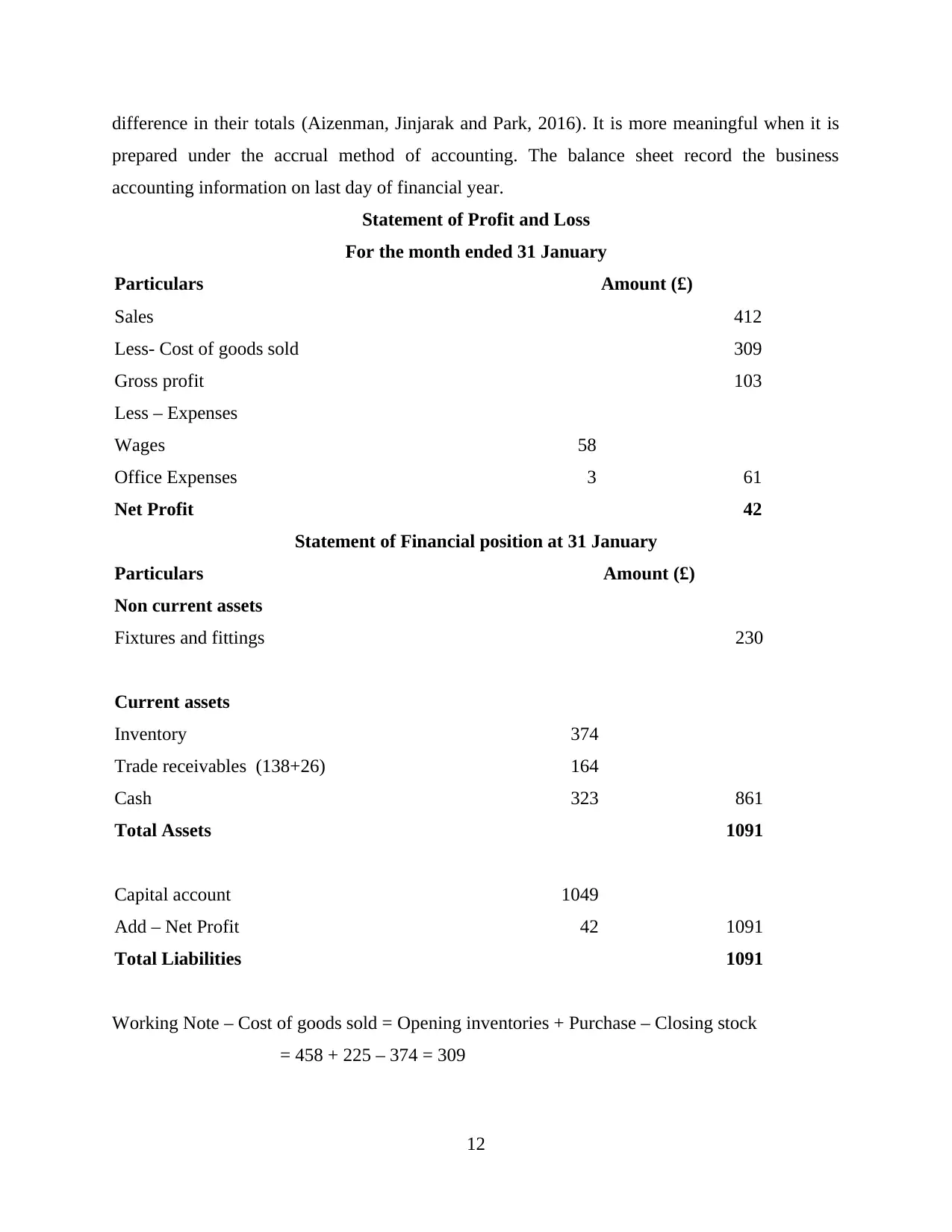
difference in their totals (Aizenman, Jinjarak and Park, 2016). It is more meaningful when it is
prepared under the accrual method of accounting. The balance sheet record the business
accounting information on last day of financial year.
Statement of Profit and Loss
For the month ended 31 January
Particulars Amount (£)
Sales 412
Less- Cost of goods sold 309
Gross profit 103
Less – Expenses
Wages 58
Office Expenses 3 61
Net Profit 42
Statement of Financial position at 31 January
Particulars Amount (£)
Non current assets
Fixtures and fittings 230
Current assets
Inventory 374
Trade receivables (138+26) 164
Cash 323 861
Total Assets 1091
Capital account 1049
Add – Net Profit 42 1091
Total Liabilities 1091
Working Note – Cost of goods sold = Opening inventories + Purchase – Closing stock
= 458 + 225 – 374 = 309
12
prepared under the accrual method of accounting. The balance sheet record the business
accounting information on last day of financial year.
Statement of Profit and Loss
For the month ended 31 January
Particulars Amount (£)
Sales 412
Less- Cost of goods sold 309
Gross profit 103
Less – Expenses
Wages 58
Office Expenses 3 61
Net Profit 42
Statement of Financial position at 31 January
Particulars Amount (£)
Non current assets
Fixtures and fittings 230
Current assets
Inventory 374
Trade receivables (138+26) 164
Cash 323 861
Total Assets 1091
Capital account 1049
Add – Net Profit 42 1091
Total Liabilities 1091
Working Note – Cost of goods sold = Opening inventories + Purchase – Closing stock
= 458 + 225 – 374 = 309
12
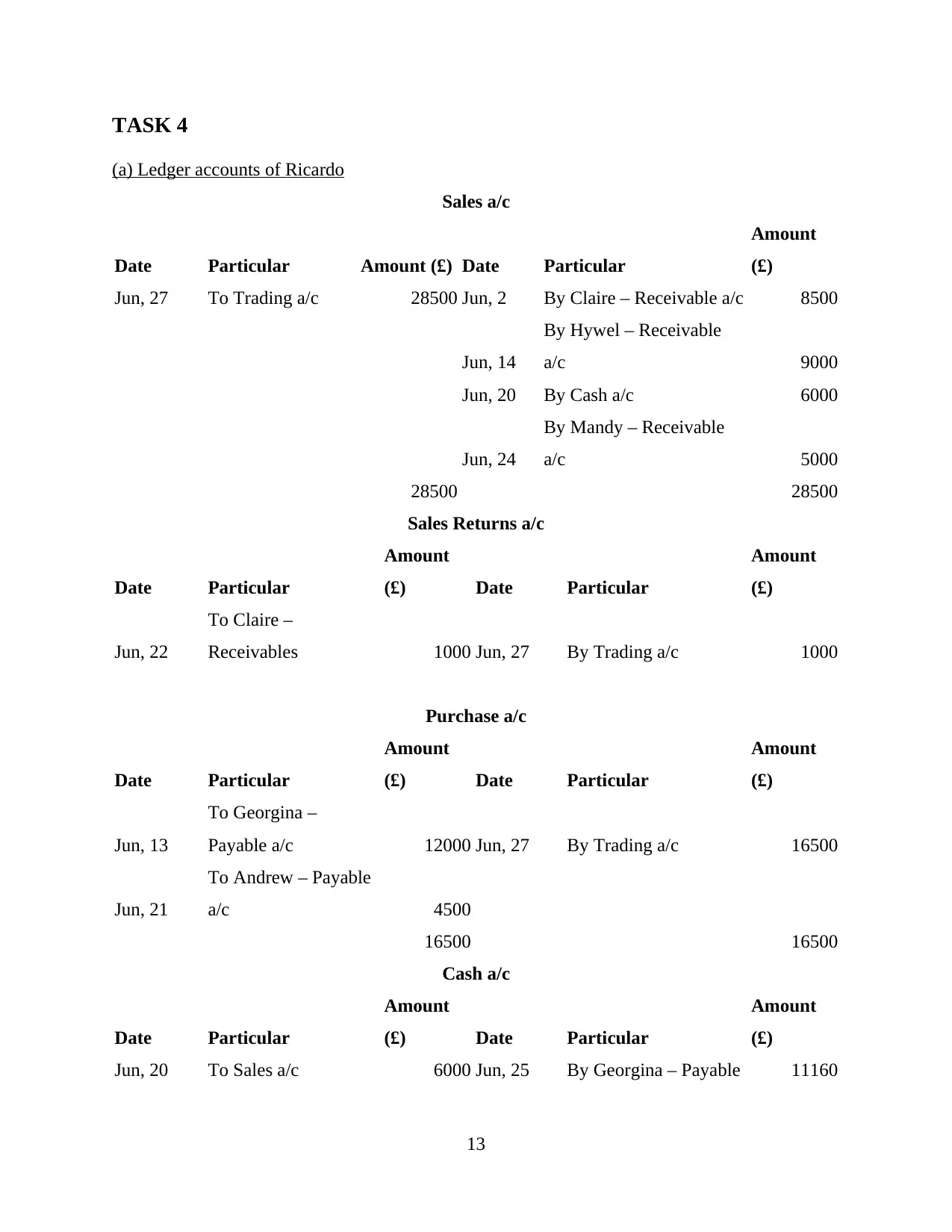
TASK 4
(a) Ledger accounts of Ricardo
Sales a/c
Date Particular Amount (£) Date Particular
Amount
(£)
Jun, 27 To Trading a/c 28500 Jun, 2 By Claire – Receivable a/c 8500
Jun, 14
By Hywel – Receivable
a/c 9000
Jun, 20 By Cash a/c 6000
Jun, 24
By Mandy – Receivable
a/c 5000
28500 28500
Sales Returns a/c
Date Particular
Amount
(£) Date Particular
Amount
(£)
Jun, 22
To Claire –
Receivables 1000 Jun, 27 By Trading a/c 1000
Purchase a/c
Date Particular
Amount
(£) Date Particular
Amount
(£)
Jun, 13
To Georgina –
Payable a/c 12000 Jun, 27 By Trading a/c 16500
Jun, 21
To Andrew – Payable
a/c 4500
16500 16500
Cash a/c
Date Particular
Amount
(£) Date Particular
Amount
(£)
Jun, 20 To Sales a/c 6000 Jun, 25 By Georgina – Payable 11160
13
(a) Ledger accounts of Ricardo
Sales a/c
Date Particular Amount (£) Date Particular
Amount
(£)
Jun, 27 To Trading a/c 28500 Jun, 2 By Claire – Receivable a/c 8500
Jun, 14
By Hywel – Receivable
a/c 9000
Jun, 20 By Cash a/c 6000
Jun, 24
By Mandy – Receivable
a/c 5000
28500 28500
Sales Returns a/c
Date Particular
Amount
(£) Date Particular
Amount
(£)
Jun, 22
To Claire –
Receivables 1000 Jun, 27 By Trading a/c 1000
Purchase a/c
Date Particular
Amount
(£) Date Particular
Amount
(£)
Jun, 13
To Georgina –
Payable a/c 12000 Jun, 27 By Trading a/c 16500
Jun, 21
To Andrew – Payable
a/c 4500
16500 16500
Cash a/c
Date Particular
Amount
(£) Date Particular
Amount
(£)
Jun, 20 To Sales a/c 6000 Jun, 25 By Georgina – Payable 11160
13
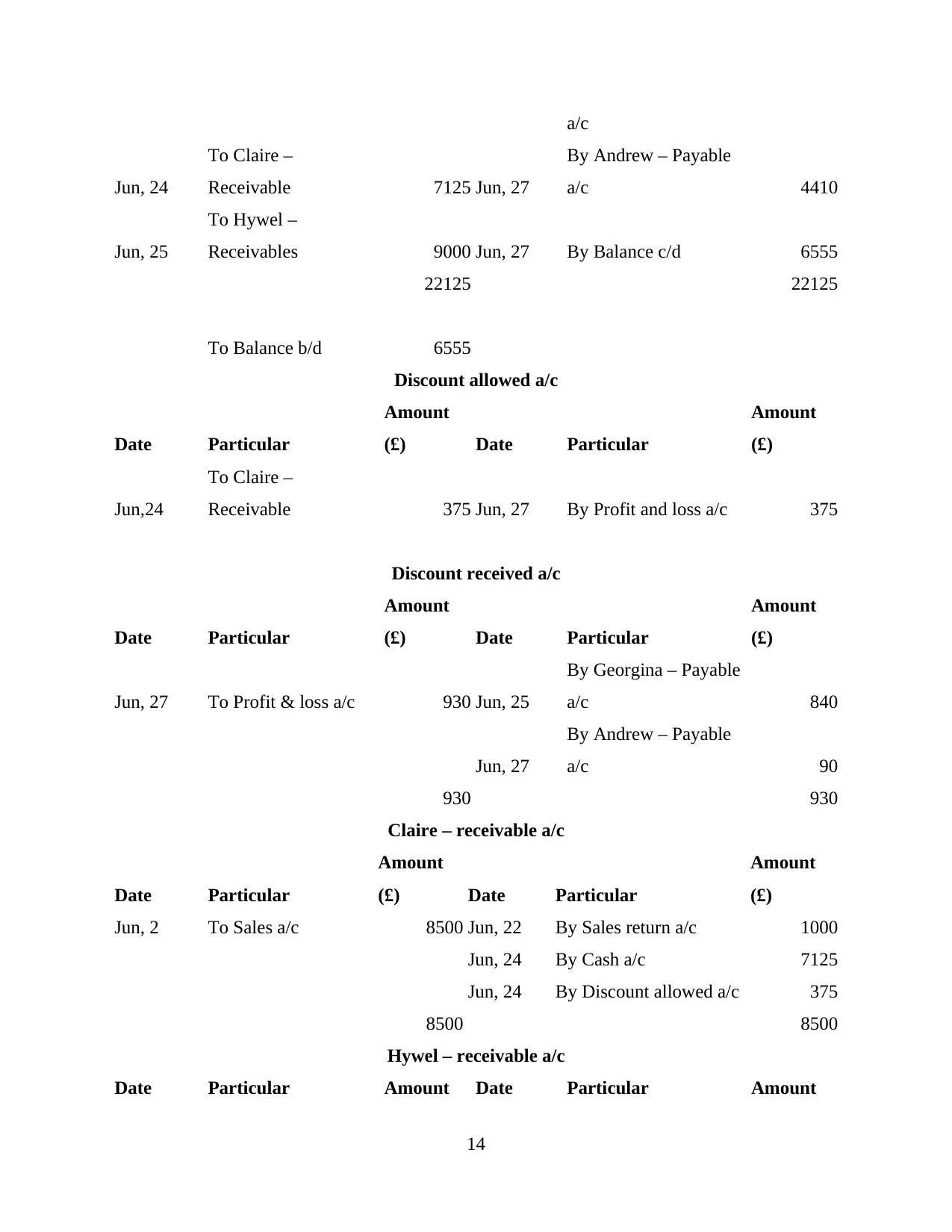
a/c
Jun, 24
To Claire –
Receivable 7125 Jun, 27
By Andrew – Payable
a/c 4410
Jun, 25
To Hywel –
Receivables 9000 Jun, 27 By Balance c/d 6555
22125 22125
To Balance b/d 6555
Discount allowed a/c
Date Particular
Amount
(£) Date Particular
Amount
(£)
Jun,24
To Claire –
Receivable 375 Jun, 27 By Profit and loss a/c 375
Discount received a/c
Date Particular
Amount
(£) Date Particular
Amount
(£)
Jun, 27 To Profit & loss a/c 930 Jun, 25
By Georgina – Payable
a/c 840
Jun, 27
By Andrew – Payable
a/c 90
930 930
Claire – receivable a/c
Date Particular
Amount
(£) Date Particular
Amount
(£)
Jun, 2 To Sales a/c 8500 Jun, 22 By Sales return a/c 1000
Jun, 24 By Cash a/c 7125
Jun, 24 By Discount allowed a/c 375
8500 8500
Hywel – receivable a/c
Date Particular Amount Date Particular Amount
14
Jun, 24
To Claire –
Receivable 7125 Jun, 27
By Andrew – Payable
a/c 4410
Jun, 25
To Hywel –
Receivables 9000 Jun, 27 By Balance c/d 6555
22125 22125
To Balance b/d 6555
Discount allowed a/c
Date Particular
Amount
(£) Date Particular
Amount
(£)
Jun,24
To Claire –
Receivable 375 Jun, 27 By Profit and loss a/c 375
Discount received a/c
Date Particular
Amount
(£) Date Particular
Amount
(£)
Jun, 27 To Profit & loss a/c 930 Jun, 25
By Georgina – Payable
a/c 840
Jun, 27
By Andrew – Payable
a/c 90
930 930
Claire – receivable a/c
Date Particular
Amount
(£) Date Particular
Amount
(£)
Jun, 2 To Sales a/c 8500 Jun, 22 By Sales return a/c 1000
Jun, 24 By Cash a/c 7125
Jun, 24 By Discount allowed a/c 375
8500 8500
Hywel – receivable a/c
Date Particular Amount Date Particular Amount
14
Secure Best Marks with AI Grader
Need help grading? Try our AI Grader for instant feedback on your assignments.
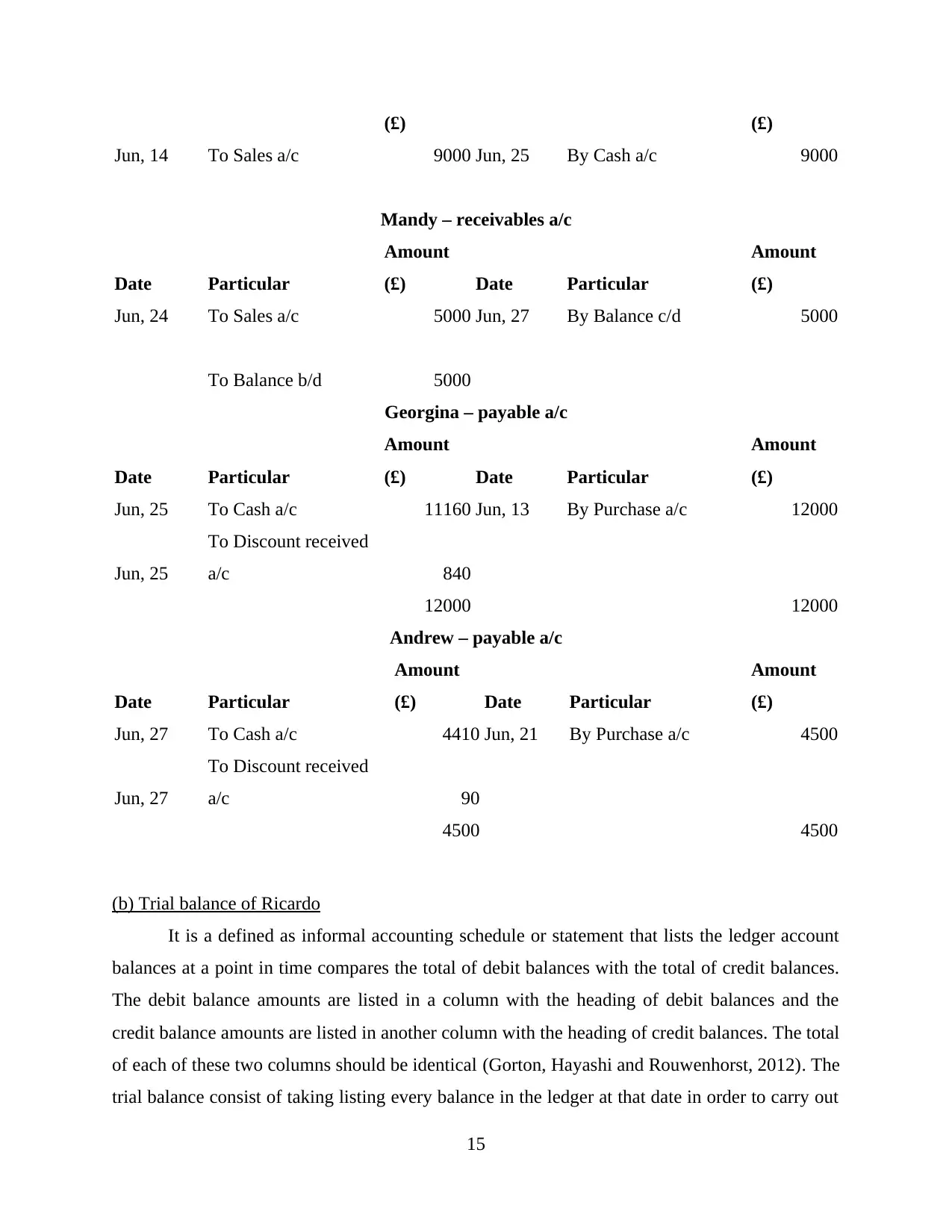
(£) (£)
Jun, 14 To Sales a/c 9000 Jun, 25 By Cash a/c 9000
Mandy – receivables a/c
Date Particular
Amount
(£) Date Particular
Amount
(£)
Jun, 24 To Sales a/c 5000 Jun, 27 By Balance c/d 5000
To Balance b/d 5000
Georgina – payable a/c
Date Particular
Amount
(£) Date Particular
Amount
(£)
Jun, 25 To Cash a/c 11160 Jun, 13 By Purchase a/c 12000
Jun, 25
To Discount received
a/c 840
12000 12000
Andrew – payable a/c
Date Particular
Amount
(£) Date Particular
Amount
(£)
Jun, 27 To Cash a/c 4410 Jun, 21 By Purchase a/c 4500
Jun, 27
To Discount received
a/c 90
4500 4500
(b) Trial balance of Ricardo
It is a defined as informal accounting schedule or statement that lists the ledger account
balances at a point in time compares the total of debit balances with the total of credit balances.
The debit balance amounts are listed in a column with the heading of debit balances and the
credit balance amounts are listed in another column with the heading of credit balances. The total
of each of these two columns should be identical (Gorton, Hayashi and Rouwenhorst, 2012). The
trial balance consist of taking listing every balance in the ledger at that date in order to carry out
15
Jun, 14 To Sales a/c 9000 Jun, 25 By Cash a/c 9000
Mandy – receivables a/c
Date Particular
Amount
(£) Date Particular
Amount
(£)
Jun, 24 To Sales a/c 5000 Jun, 27 By Balance c/d 5000
To Balance b/d 5000
Georgina – payable a/c
Date Particular
Amount
(£) Date Particular
Amount
(£)
Jun, 25 To Cash a/c 11160 Jun, 13 By Purchase a/c 12000
Jun, 25
To Discount received
a/c 840
12000 12000
Andrew – payable a/c
Date Particular
Amount
(£) Date Particular
Amount
(£)
Jun, 27 To Cash a/c 4410 Jun, 21 By Purchase a/c 4500
Jun, 27
To Discount received
a/c 90
4500 4500
(b) Trial balance of Ricardo
It is a defined as informal accounting schedule or statement that lists the ledger account
balances at a point in time compares the total of debit balances with the total of credit balances.
The debit balance amounts are listed in a column with the heading of debit balances and the
credit balance amounts are listed in another column with the heading of credit balances. The total
of each of these two columns should be identical (Gorton, Hayashi and Rouwenhorst, 2012). The
trial balance consist of taking listing every balance in the ledger at that date in order to carry out
15
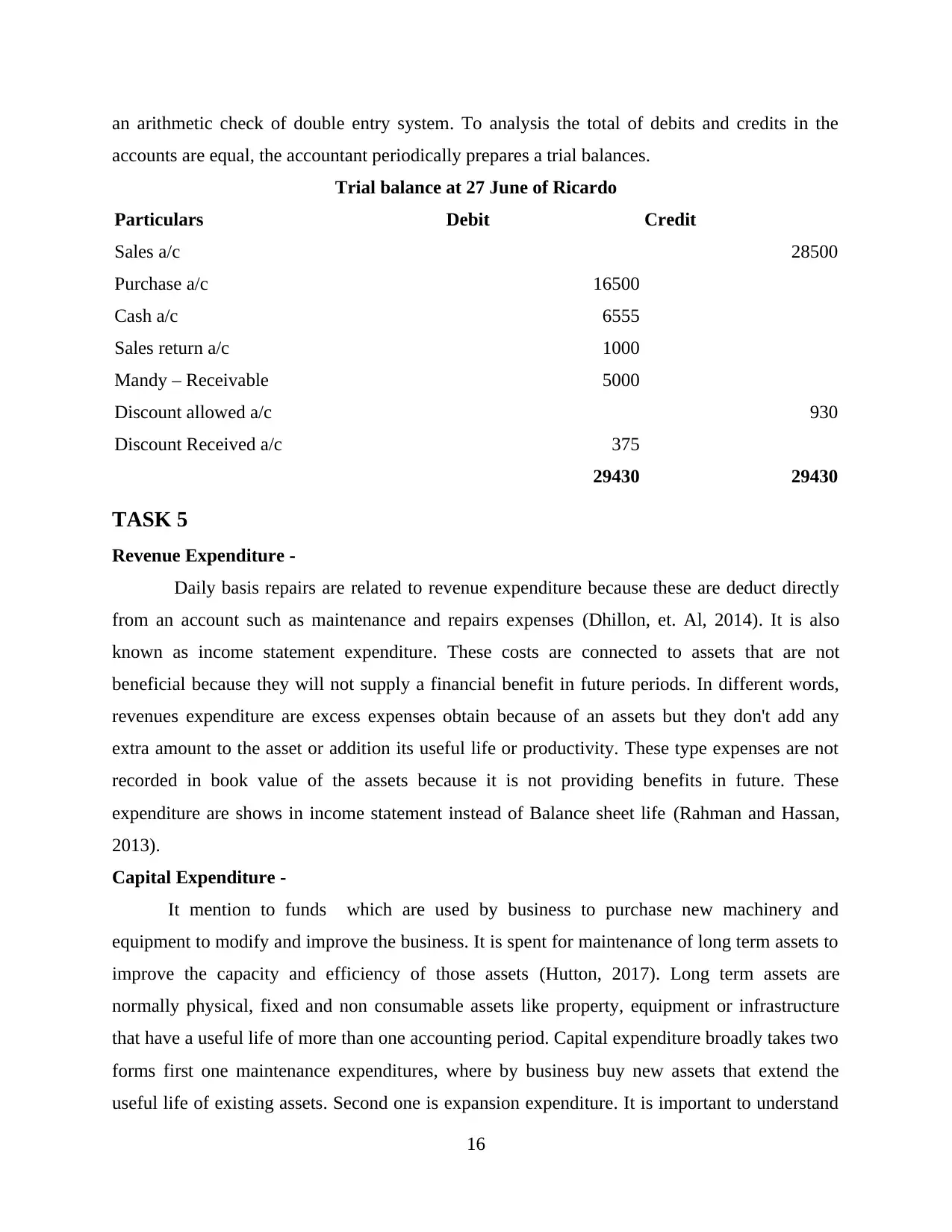
an arithmetic check of double entry system. To analysis the total of debits and credits in the
accounts are equal, the accountant periodically prepares a trial balances.
Trial balance at 27 June of Ricardo
Particulars Debit Credit
Sales a/c 28500
Purchase a/c 16500
Cash a/c 6555
Sales return a/c 1000
Mandy – Receivable 5000
Discount allowed a/c 930
Discount Received a/c 375
29430 29430
TASK 5
Revenue Expenditure -
Daily basis repairs are related to revenue expenditure because these are deduct directly
from an account such as maintenance and repairs expenses (Dhillon, et. Al, 2014). It is also
known as income statement expenditure. These costs are connected to assets that are not
beneficial because they will not supply a financial benefit in future periods. In different words,
revenues expenditure are excess expenses obtain because of an assets but they don't add any
extra amount to the asset or addition its useful life or productivity. These type expenses are not
recorded in book value of the assets because it is not providing benefits in future. These
expenditure are shows in income statement instead of Balance sheet life (Rahman and Hassan,
2013).
Capital Expenditure -
It mention to funds which are used by business to purchase new machinery and
equipment to modify and improve the business. It is spent for maintenance of long term assets to
improve the capacity and efficiency of those assets (Hutton, 2017). Long term assets are
normally physical, fixed and non consumable assets like property, equipment or infrastructure
that have a useful life of more than one accounting period. Capital expenditure broadly takes two
forms first one maintenance expenditures, where by business buy new assets that extend the
useful life of existing assets. Second one is expansion expenditure. It is important to understand
16
accounts are equal, the accountant periodically prepares a trial balances.
Trial balance at 27 June of Ricardo
Particulars Debit Credit
Sales a/c 28500
Purchase a/c 16500
Cash a/c 6555
Sales return a/c 1000
Mandy – Receivable 5000
Discount allowed a/c 930
Discount Received a/c 375
29430 29430
TASK 5
Revenue Expenditure -
Daily basis repairs are related to revenue expenditure because these are deduct directly
from an account such as maintenance and repairs expenses (Dhillon, et. Al, 2014). It is also
known as income statement expenditure. These costs are connected to assets that are not
beneficial because they will not supply a financial benefit in future periods. In different words,
revenues expenditure are excess expenses obtain because of an assets but they don't add any
extra amount to the asset or addition its useful life or productivity. These type expenses are not
recorded in book value of the assets because it is not providing benefits in future. These
expenditure are shows in income statement instead of Balance sheet life (Rahman and Hassan,
2013).
Capital Expenditure -
It mention to funds which are used by business to purchase new machinery and
equipment to modify and improve the business. It is spent for maintenance of long term assets to
improve the capacity and efficiency of those assets (Hutton, 2017). Long term assets are
normally physical, fixed and non consumable assets like property, equipment or infrastructure
that have a useful life of more than one accounting period. Capital expenditure broadly takes two
forms first one maintenance expenditures, where by business buy new assets that extend the
useful life of existing assets. Second one is expansion expenditure. It is important to understand
16
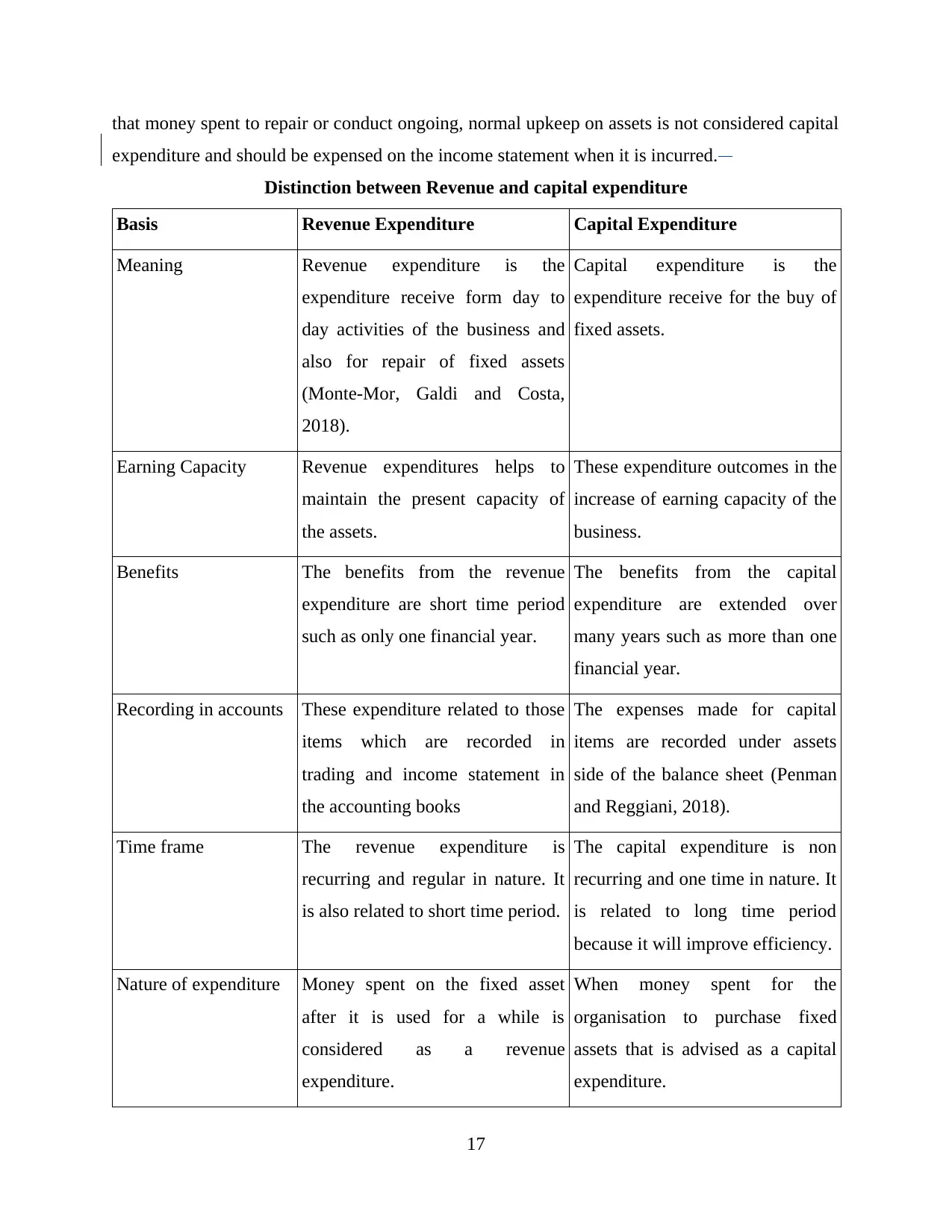
that money spent to repair or conduct ongoing, normal upkeep on assets is not considered capital
expenditure and should be expensed on the income statement when it is incurred.
Distinction between Revenue and capital expenditure
Basis Revenue Expenditure Capital Expenditure
Meaning Revenue expenditure is the
expenditure receive form day to
day activities of the business and
also for repair of fixed assets
(Monte‐Mor, Galdi and Costa,
2018).
Capital expenditure is the
expenditure receive for the buy of
fixed assets.
Earning Capacity Revenue expenditures helps to
maintain the present capacity of
the assets.
These expenditure outcomes in the
increase of earning capacity of the
business.
Benefits The benefits from the revenue
expenditure are short time period
such as only one financial year.
The benefits from the capital
expenditure are extended over
many years such as more than one
financial year.
Recording in accounts These expenditure related to those
items which are recorded in
trading and income statement in
the accounting books
The expenses made for capital
items are recorded under assets
side of the balance sheet (Penman
and Reggiani, 2018).
Time frame The revenue expenditure is
recurring and regular in nature. It
is also related to short time period.
The capital expenditure is non
recurring and one time in nature. It
is related to long time period
because it will improve efficiency.
Nature of expenditure Money spent on the fixed asset
after it is used for a while is
considered as a revenue
expenditure.
When money spent for the
organisation to purchase fixed
assets that is advised as a capital
expenditure.
17
expenditure and should be expensed on the income statement when it is incurred.
Distinction between Revenue and capital expenditure
Basis Revenue Expenditure Capital Expenditure
Meaning Revenue expenditure is the
expenditure receive form day to
day activities of the business and
also for repair of fixed assets
(Monte‐Mor, Galdi and Costa,
2018).
Capital expenditure is the
expenditure receive for the buy of
fixed assets.
Earning Capacity Revenue expenditures helps to
maintain the present capacity of
the assets.
These expenditure outcomes in the
increase of earning capacity of the
business.
Benefits The benefits from the revenue
expenditure are short time period
such as only one financial year.
The benefits from the capital
expenditure are extended over
many years such as more than one
financial year.
Recording in accounts These expenditure related to those
items which are recorded in
trading and income statement in
the accounting books
The expenses made for capital
items are recorded under assets
side of the balance sheet (Penman
and Reggiani, 2018).
Time frame The revenue expenditure is
recurring and regular in nature. It
is also related to short time period.
The capital expenditure is non
recurring and one time in nature. It
is related to long time period
because it will improve efficiency.
Nature of expenditure Money spent on the fixed asset
after it is used for a while is
considered as a revenue
expenditure.
When money spent for the
organisation to purchase fixed
assets that is advised as a capital
expenditure.
17
1 out of 19
Related Documents
Your All-in-One AI-Powered Toolkit for Academic Success.
+13062052269
info@desklib.com
Available 24*7 on WhatsApp / Email
![[object Object]](/_next/static/media/star-bottom.7253800d.svg)
Unlock your academic potential
© 2024 | Zucol Services PVT LTD | All rights reserved.





